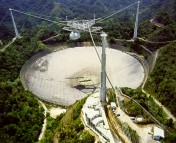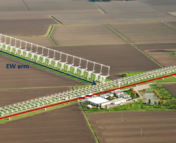Title: Fast radio bursts to be detected with the Square Kilometre Array
Authors: Tetsuya Hashimoto, Tomotsugu Goto, Alvina Y. L. On, Ting-Yi Lu, Daryl Joe D. Santos, Simon C.-C. Ho, Ting-Wen Wang, Seong Jin Kim, and Tiger Y.-Y. Hsiao
First Author’s Institution: Institute of Astronomy, National Tsing Hua University, 101, Section 2. Kuang-Fu Road, Hsinchu, 30013, Taiwan (R.O.C.)
Status: Accepted for publication in MNRAS; open access on arXiv
A field of study perfect for the radio astronomy and mystery-loving aficionado, fast radio bursts (FRBs) are an extremely energetic astrophysical phenomena — each burst of radio emission lasting just a few milliseconds — with causes that are still unknown. Most FRBs are extragalactic: of the ~100+ verified FRBs detected to date, nine FRBs have been localized to host galaxies outside our own, although very recently, an FRB was detected from within the Milky Way. The FRBs detected thus far have been due to instruments such as the Canadian Hydrogen Intensity Mapping Experiment (CHIME) FRB project and the Parkes Observatory. However, we would need to detect many more FRBs if we want to use FRBs to address cosmological science questions. In order to increase the number of FRBs needed to answer these questions, we will likely need a new generation of advanced radio telescopes.
One of the most promising — and ambitious — proposed next-generation radio telescopes is the Square Kilometre Array (SKA). The SKA has a design of thousands of antennas and dishes observing the sky with over a square kilometer of collecting area over a frequency range of 50 MHz to 14 GHz. Its sensitivity, angular resolution, field of view, and sky mapping speed would all be better than those of current radio telescopes. Today’s paper adopts the sensitivity of Phase 2 of the SKA (SKA2) and tries to answer the question: How many FRBs could the SKA detect?
Not all FRBs are the same
While we have observed both repeating and non-repeating FRBs, it is not yet known whether these two populations originate from physically distinct sources. However, the two populations exhibit some different observed physical properties — their empirically-derived luminosity functions, the number density per volume (in this case, of FRBs) as a function of the sum of all observed luminosity over a given timescale, appear to be different.
Previous work has found that repeating FRBs have luminosity functions that are much higher than that of non-repeating FRBs. Additionally, because luminosity functions can depend on redshift, today’s paper considers the redshift evolution of each luminosity function scaling with either the cosmic stellar mass-density (CSMD; the mass in stars per unit volume) evolution or the cosmic star formation rate-density (CSFRD; the stellar formation per unit volume) evolution (Figure 1). The former scenario supports the theory of old populations being FRB progenitors (e.g. white dwarfs, neutron stars, and black holes), while the latter supports the theory of young stellar populations being FRB progenitors (e.g. supernova remnants, magnetars, and pulsars). Unlike previous studies, today’s paper predicts the number of detected FRBs by separately estimating the detections of non-repeating and repeating FRBs, based on their respective luminosity functions and redshift evolutions.

Estimating the number of detected FRBs
The luminosity functions used for the repeating FRBs were calculated from CHIME detections, and the luminosity functions used for the non-repeating FRBs were calculated from Parkes detections. All the data was obtained from the FRB Catalogue (FRBCAT) and references within. The calculated expected numbers of detected FRBs depend on various assumptions that go into the model: the two considered observed frequencies (0.65 GHz or 1.4 GHz), the possible considered characteristic spectral index of the FRB (α = –0.3, –1.0, and –1.5), the integration range of the luminosity function (denoted by the horizontal arrows in Figure 1), and the considered redshift evolutions (CSMD or CSFRD). The cumulative number of detected FRBs were then calculated, and shown in Figure 2.

The y-axis of Figure 2 is in logarithmic scale, and looking at the left-hand side of the y-axis we see that roughly 105 – 106 non-repeating FRBs total, and roughly 103 repeating FRBs total, could be seen by SKA in its field of view every year. If we look at the right-hand side, we can see the corresponding cumulative numbers of FRBs detected in the sky per day. For example, assuming non-repeating FRBs have luminosity functions that scale with the CSMD, at z ≥ 2, the SKA can detect roughly 104 over the sky every day. (For context, the furthest currently localized FRB is at z=0.66.)
In all the considered scenarios, SKA would detect at least a hundred times more FRBs per year than have been detected to-date! This huge amount of FRB detections would help constrain the FRB luminosity functions, their redshift evolutions, and thus their associated stellar populations, helping constrain the origins of these repeating and non-repeating FRBs. Additionally, with increased numbers of FRB detections, FRBs can be used to constrain cosmological parameters and explore cosmic reionization, leading to lots of exciting discoveries to be made with and about FRBs.





Very nice summary, thanks!
Thank you!